Lucid Hydra 200: Vendor Agnostic Multi-GPU, Available in 30 Days
by Anand Lal Shimpi on September 22, 2009 5:00 PM EST- Posted in
- GPUs
A year ago Lucid announced the Hydra 100: a physical chip that could enable hardware multi-GPU without any pesky SLI/Crossfire software, game profiles or anything like that.
At a high level what Lucid's technology does is intercept OpenGL/DirectX commands from the CPU to the GPU and load balance them across any number of GPUs. The final buffers are read back by the Lucid chip and sent to primary GPU for display.
The technology sounds flawless. You don't need to worry about game profiles or driver support, you just add more GPUs and they should be perfectly load balanced. Even more impressive is Lucid's claim that you can mix and match GPUs of different performance levels. For example you could put a GeForce GTX 285 and a GeForce 9800 GTX in parallel and the two would be perfectly load balanced by Lucid's hardware; you'd get a real speedup. Eventually, Lucid will also enable multi-GPU configurations from different vendors (e.g. one NVIDIA GPU + one AMD GPU).
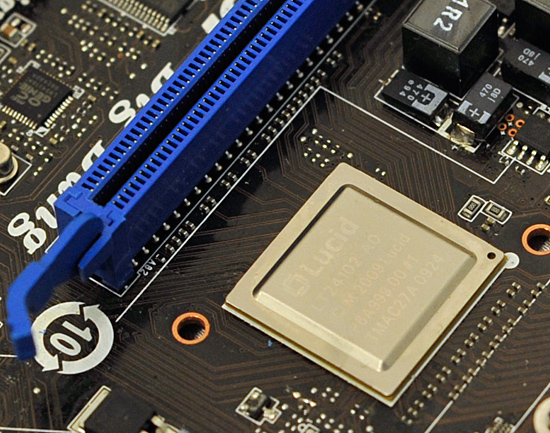
At least on paper, Lucid's technology has the potential to completely eliminate all of the multi-GPU silliness we've been dealing with for the past several years. Today, Lucid is announcing the final set of hardware that will be shipping within the next ~30 days.
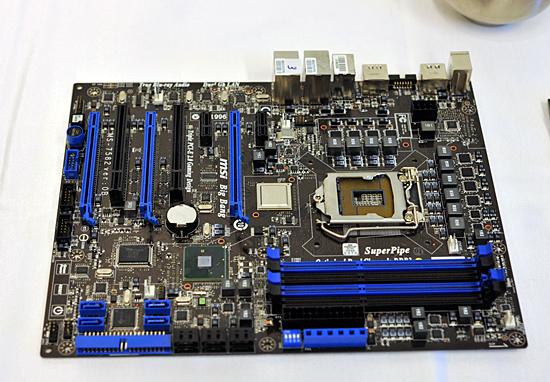
The MSI Big Bang, a P55 motherboard with Lucid's Hydra 200
It's called the Hydra 200 and it will first be featured on MSI's Big Bang P55 motherboard. Unlike the Hydra 100 we talked about last year, 200 is built on a 65nm process node instead of 130nm. The architecture is widely improved thanks to much more experience with the chip on Lucid's part.

There are three versions of the Hydra 200: the LT22114, the LT22102 and the LT22114. The only difference between the chips are the number of PCIe lanes. The lowest end chip has a x8 connection to the CPU/PCIe controller and two x8 connections to GPUs. The midrange LT22102 has a x16 connection to the CPU and two x16 connections for GPUs. And the highest end solution, the one being used on the MSI board, has a x16 to the CPU and then a configurable pair of x16s to GPUs. You can operate this controller in 4 x8 mode, 1 x16 + 2 x8 or 2 x16. It's all auto sensing and auto-configurable. The high end product will be launching in October, with the other two versions shipping into mainstream and potentially mobile systems some time later.
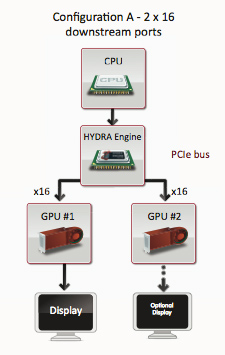
Lucid wouldn't tell us the added cost on a motherboard but Lucid gave us the guidance of around $1.50 per PCIe lane. The high end chip has 48 total PCIe lanes, which puts the premium at $72. The low end chip has 24 lanes, translating into a $36 cost for the Hydra 200 chip. Note that since the Hydra 200 has an integrated PCIe switch, there's no need for extra chips on the motherboard (and of course no SLI licensing fees). The first implementation of the Hydra 200 will be on MSI's high end P55 motherboard, so we can expect prices to be at the upper end of the spectrum. With enough support, we could see that fall into the upper mainstream segment.
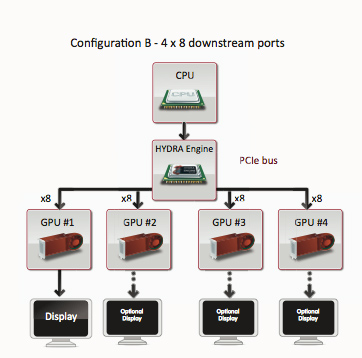
Lucid specs the Hydra 200 at a 6W TDP.
Also unlike last year, we actually got real seat time with the Hydra 200 and MSI's Big Bang. Even better: we got to play on a GeForce GTX 260 + ATI Radeon HD 4890 running in multi-GPU mode.
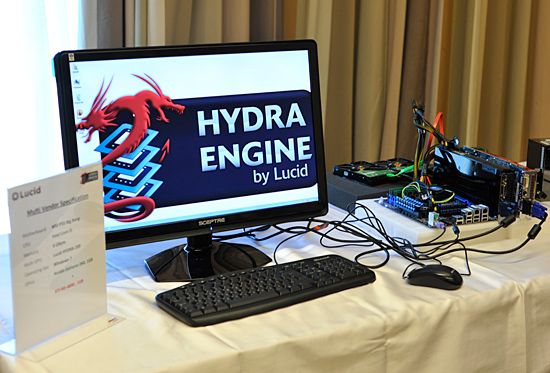
Of course with two different GPU vendors, we need Windows 7 to allow both drivers to work at the same time. Lucid's software runs in the background and lets you enable/disable multi-GPU mode:

If for any reason Lucid can't run a game in multi-GPU mode, it will always fall back to working on a single GPU without any interaction from the end user. Lucid claims to be able to accelerate all DX9 and DX10 games, although things like AA become easier in DX10 since all hardware should resolve the same way.
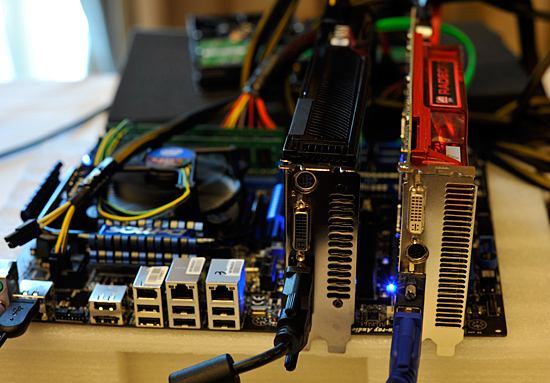
NVIDIA and ATI running in multi-GPU mode on a single system

There are a lot of questions about performance and compatibility, but honestly we can't say much on that until we get the hardware ourselves. We were given some time to play with the system and can say that it at least works.
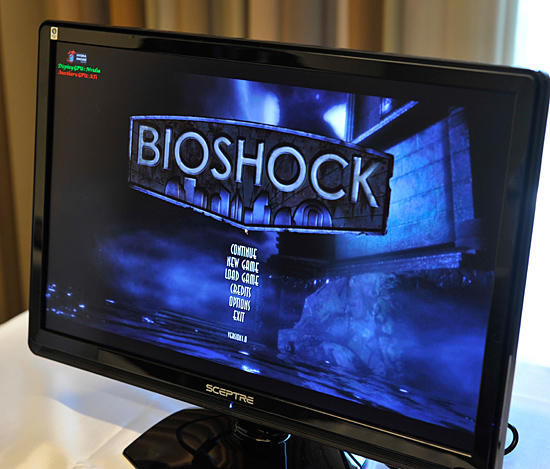
Lucid only had two games installed on the cross-vendor GPU setup: Bioshock and FEAR 2. There are apparently more demos at the show floor, we'll try and bring more impressions from IDF later this week.










94 Comments
View All Comments
Akrovah - Thursday, September 24, 2009 - link
Generally speaking (off the top of my head, I realy have no idea if thsi is true or not) I think this is accomplished by having all data needed to render a scene, geometry, textures, shaders, etc... on both cards, but each card is only given half of the scene to actually render.snarfbot - Tuesday, September 22, 2009 - link
i cant believe they actually are coming to market, everyone was talking about how this was too good to be true and here it is.i cant wait for the benchmarks, if this is as good as it says it is, im buying.
its time for an upgrade anyway.
formulav8 - Tuesday, September 22, 2009 - link
Even besides the performance aspect, which they apparently didn't give any real-world figures to ponder over (I may have overlooked it though), a great many people will not buy it with such a high premium. Over $70 for the higher lane part is nutty. I will be perfectly content with AMD's and NVidias approach thankyou....Jason
JonnyDough - Wednesday, September 23, 2009 - link
Fool.wumpus - Wednesday, September 23, 2009 - link
I'm having trouble seeing what is so great about this. It looks like paying $75 to $150 just to cut your graphics bandwidth in half. If you throw it on the P55 motherboard, you aren't losing anything in SLI mode (only one x16 lane anyway), but why pay extra money for less bandwidth anyway?I will say this. My hat is off to anyone who buys this and can succeeds in making at least one fanboy's head explode (ATI and NVidia in the same board???!!!EleventyOne!!!????).
tamalero - Thursday, September 24, 2009 - link
who cares about lanes, if they acomplish what they promised of almost linear scaling, its a hell lot more acomplish than the 60% average performance increase from single to dual in both nvidia and ATI.formulav8 - Wednesday, September 23, 2009 - link
Thanks!DigitalFreak - Tuesday, September 22, 2009 - link
$72? That's ridiculous. Even an entire chipset rarely cost that much.inighthawki - Tuesday, September 22, 2009 - link
true, but keep in mind, assuming it works, it is quite an amazing chip and does far more than a lot of other things can, plus the demand of the chip is going to be fairly low. Unlike a chipset which is needed on EVERY computer, this will only be features in the higher end motherboards. Basic economics...Chlorus - Tuesday, September 22, 2009 - link
I don't think their target market really cares about price - after all, running four cards in SLI tends to be pretty expensive.